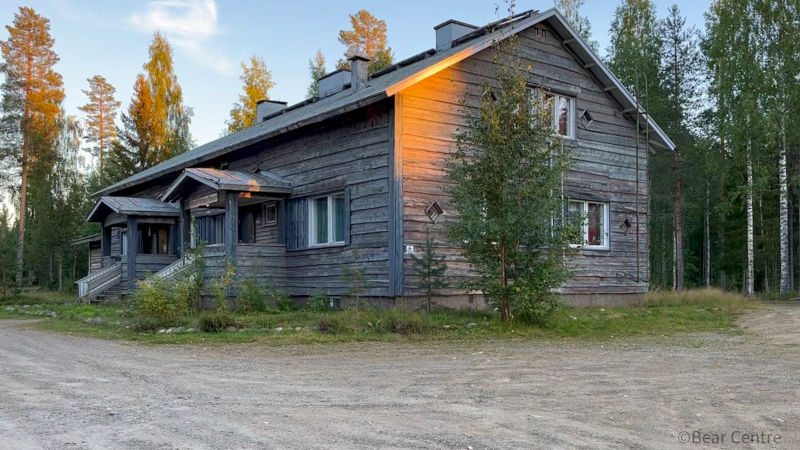REGION
FinlandTHEME
WildlifeACTIVITIES
Bear, BirdsDURATION
1 nightDIFFICULTY
Very easyExperience to remember !
Bear Centre is specialising in bear, wolverine and wolf photography and watching.
The center has a total of 29 different hides suitable for both photography and observation.
The region offers a wide variety of terrains, providing photographers with an excellent opportunity to capture wildlife at close range against various backgrounds.
Meals and accommodation are provided in a beautiful lodge on the shore of a large lake, located just a few steps away from the hides.
Detailed program
Bear observation
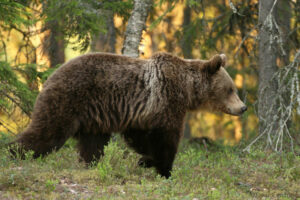
The season begins in early April with a blanket of white snow, continues through the lush greenery of summer, and concludes with the colors of autumn until October.
The bear observation season lasts approximately six months, starting when the first bear arrives in the hide area after hibernation and ending in autumn when the last bear departs for winter hibernation.
Being so far north, the sun rises and sets slowly, and spring nights are slightly longer and darker. Each day, daylight duration increases towards summer, and midsummer nights are bright enough for observation and photography throughout the night.
PATIENCE IS KEY
Remember that bears are wild animals and move freely according to their own schedule. Sometimes, just one night is enough to see bears. The likelihood of seeing a bear is 90 to 99%, depending on the month.
Each season, approximately 20 to 30 bears visit the hide area. Some evenings, several bears can be seen at the same time, and the closest bear may be just a few meters away from the hide. In addition to bears, the hide area is regularly visited by 1 to 4 different wolverines, foxes, and the local wolf pack 1 to 2 times per week.
Bear Photography

The bear photography season lasts approximately six months, starting when the first bear arrives in the hide area after hibernation and ending in autumn when the last bear departs for winter hibernation.
The season begins in early April with a blanket of white snow, continues through the lush greenery of summer, and concludes with the colors of autumn until October.
In this northern region, the sun sets and rises slowly, and spring nights are slightly longer and darker. With each passing day, daylight duration increases towards summer, and midsummer nights are bright enough for photography throughout the night. Then, daylight duration slowly decreases towards autumn for darker nights again. Due to this change in light, it’s possible to photograph bears in various lighting situations.
GETTING THE PHOTO
So, what does it take to get good photos, and what do the changing seasons offer photographers?
Remember that even though the photographer may expect certain things, bears are wild animals, and they move with freedom and according to their own schedule. Photographers must be patient and remain absolutely silent when photographing from the hides.
Sometimes, just one night is enough to get the desired photos. On average, 3 to 5 nights ensure better results. The likelihood of seeing and photographing a bear is 90 to 99% over a 3 to 5-day stay, depending on the month. Each season, approximately 20 to 30 bears visit the hide area. Some evenings, several bears can be seen at the same time, and the closest bear may be just a few meters away from the hide. In addition to bears, the hide area is regularly visited by 1 to 4 different wolverines, foxes, and 1 to 2 times per week by the local wolf pack.
Nordic species
BROWN BEAR
URSUS ARCTOS
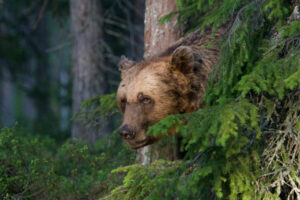
The brown bear is the most variable in size among modern bears. Typical size depends on the population it belongs to, and most accepted subtypes vary considerably in size. Individual bears also vary in size depending on the seasons, weighing the least in spring due to the lack of food searching during hibernation, and the most in late autumn, after a period of hyperphagia to gain extra weight in preparation for hibernation.
The brown bear is often described as nocturnal. However, it often appears to be most active in the morning and early evening. Additionally, one-year-old bears and newly independent bears are more likely to be active during the day, and many adult bears in undisturbed areas are largely crepuscular. From summer to autumn, a brown bear can double its weight from spring, gaining up to 180 kg of fat, which it relies on to survive the winter, during which it becomes very lethargic.
WOLF
CANIS LUPUS
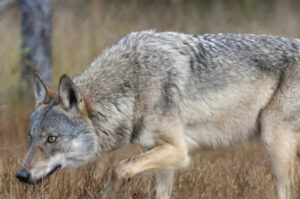
The wolf is the largest member of the Canidae family. It is slim and powerfully built with a broad and deeply descending chest, a sloping back, and a strongly muscled neck. The wolf’s legs are moderately longer than those of other canids, allowing the animal to move quickly and overcome the deep snow covering much of its geographical range. The wolf’s head is large and heavy, with a broad forehead, powerful jaws, and a long, blunt muzzle. The teeth are heavy and large, making them better suited for crushing bones than those of other canids.
Like all land mammals that hunt in packs, the wolf primarily feeds on wild herbivorous mammals with hooves, which may have a body mass similar to that of the entire pack. The wolf specializes in preying on vulnerable individuals of large prey, with a pack capable of bringing down a 500 kg moose.
WOLVERINE
GULO GULO
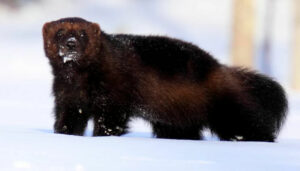
The wolverine is a stocky and muscular animal. With short legs, a wide and rounded head, small eyes, and short, rounded ears, it resembles more of a bear than other mustelids. Although its legs are short, its wide five-toed paws with crampon-like claws and its plantigrade posture enable it to climb steep cliffs, trees, and snow-capped peaks with relative ease.
Wolverines are considered primarily scavengers. The majority of a wolverine’s food comes from carrion, upon which it relies almost exclusively in winter and early spring. Wolverines can find carrion themselves, feed after a predator has finished, or simply take it from another predator. Wolverines are also known to follow the tracks of wolves and lynxes, apparently with the purpose of scavenging the remains of their kills. However, this feeding style is considered an adaptation to food scarcity, especially in winter.
OWLS
STRIGIFORMES
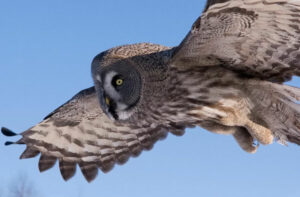
Owls have large forward-facing eyes and ear holes, a beak resembling that of a falcon, a flat face, and typically a circle of feathers, a facial disk, around each eye. The feathers forming this disk can be adjusted to sharply focus sounds from different distances onto the asymmetrically placed ear cavities of owls..
Most birds of prey have eyes on the sides of their heads, but the stereoscopic nature of owls’ forward-facing eyes allows for better depth perception necessary for hunting in low light. Since owls are farsighted, they cannot see clearly anything within a few centimeters of their eyes. Their long-distance vision, especially in low light, is exceptionally good.
EAGLES
AQUILA
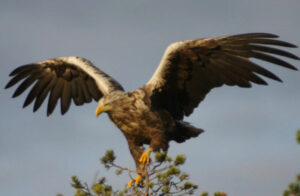
Eagles are large birds of prey, powerfully built, with heavy heads and beaks. Like all birds of prey, eagles have very large, hooked beaks for tearing flesh from their prey, strong, muscular legs, and powerful talons. The beak is typically heavier than that of most other birds of prey.
The eyes of eagles are extremely powerful. It is estimated that the martial eagle, whose eye is over two times longer than the human eye, has a visual acuity of 3.0 to 3.6 times that of humans. This acuity allows eagles to spot potential prey from a very long distance away. This sharp vision is primarily attributed to their extremely large pupils, which ensure minimal dispersion of incoming light. The female of all known species of eagles is larger than the male.
WOODPECKERS
PICUS
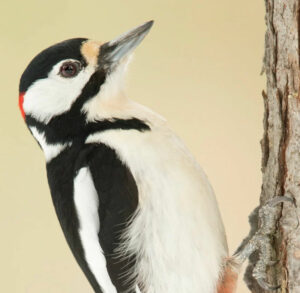
Woodpeckers have powerful beaks for pecking and drumming on trees, and long sticky tongues for extracting food. The chisel-shaped tip of the beak is kept sharp by the action of pecking in birds that use it regularly on wood. Many of the foraging, reproductive, and signaling behaviors of woodpeckers involve drumming and hammering with the beak.
The majority of woodpeckers lead solitary lives, but the spectrum of behaviors varies from highly antisocial species that are aggressive towards their counterparts, to species that live in groups. Solitary species will defend food resources such as a termite colony or a tree loaded with fruits, chasing away other individuals of the same species and returning frequently until the resource is depleted. Aggressive behaviors include pecking and jabbing with the beak, head shaking, wing flapping, chasing, drumming, and vocalizations.
Hides and info
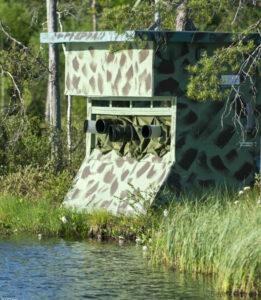
BEAR, WOLF AND WOLVERINE HIDES
The Bear Center specializes in wildlife observation at very close range, particularly of bears and wolverines. Although telephoto lenses can be effectively used, it also allows the photographer to express creativity with wide-angle lenses. The hides are also suitable for filming bears and wolverines in the same manner.
Bears and wolverines move throughout the region, and the main criterion to consider when selecting the hide is the type of landscape you wish to have. These hides are just a short walk of 500 to 900 meters from the main lodge, and a trail and boardwalks guide the way to the hides.
The walk from the main lodge to the hides is a pleasant experience. There are no steep slopes along the way, and there is an opportunity to spot different species of birds along the path.
Hides 1-12 and 15-25 are for 1-2 people.
Hide 1 can accommodate 3 people if necessary.
Hides 7a, b, 26a, b, and 27a, b can accommodate 2+2 people.
Hides 13 and 14 are for one person.
Hide A can accommodate 4 people and is suitable for families.
EQUIPEMENT IN HIDE

All hides are equipped with a chair, a bed, a mattress, a sleeping bag, a duvet, a pillow, a toilet bucket and paper, 3/8″ tripod head mounting screws, and heating if necessary in April.
It is possible to sleep in the hides, but it is not recommended to sleep during shooting sessions as bears may come at any time. Accommodation reservation allows sleeping during the day after spending the night inside the hide.
PHOTOGRAPHING



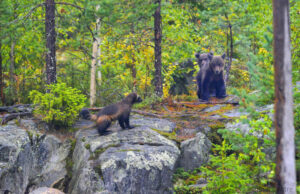
Inside the hide, more than one camera can be used as the hides have multiple camera body placements. The photographic openings are oriented in the same direction or in different directions depending on the hide. Hides for two people have a minimum of four photographic openings, while hides for one person have different photographic directions for three and four cameras.
A tripod is not necessary as photography is possible using the board inside the hide. On the board, a tripod head can be attached or a cushion can be used. If you wish to use the full tripod, it is still possible in hides for two people where the front wall is sloped.
The tripod head can be laterally moved on the wooden board, and the hides contain bolts to secure them. The camera can be rotated from 120 to 160 degrees in the photographic openings because their fabrics have been sewn together, and there is no bar between the openings to hinder rotation.
Inside the hide, it is possible to change the camera lens silently. The use of flash or flashlight is prohibited in all circumstances during shooting. It is also prohibited to leave the hide in the evening, night, or morning before the defined period. All rules provided in the departure information must be followed.
If you reserve a hide for yourself, we will not place anyone else in your hide. All hides are equipped with beds, including mattress, sleeping bag, duvet, pillow. Most hides have beds as shown in the attached image. Hide 1 has a lower bed and a mattress with bedding to be placed on the floor. Additionally, hides for one person, 13 and 14, have a mattress with bedding to be placed on the floor. Hides also include a toilet bucket and paper inside the hide.
Most of the hides have a front wall designed to be sloped, allowing for the use of a full tripod set in almost all of our hides. Our specially designed photography board is even more convenient for photography. We have these photography boards and bolts to secure the tripod head in each hide.
And you can use as many cameras as possible, at no extra cost.
LOW LEVEL PHOTOGRAPHY OPENING
Installed in hides 11, 15, 17-25.
Check the front window before starting the night; if it’s closed, you can open it for the night. In the morning, you can close the window. Lower-level openings do not have a photography board; a cushion or similar is best.
ACCOMMODATION ET SERVICES
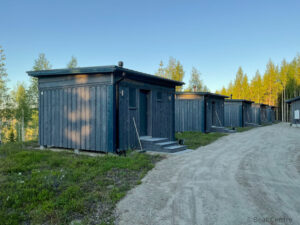

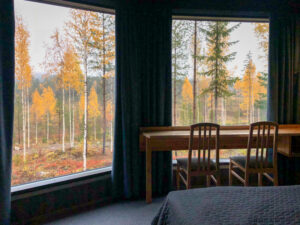

It is possible to sleep in the hides, but it is not recommended to sleep during the shooting as bears may come at any time. Accommodation reservation allows sleeping during the day after spending the night inside the hide. Especially in summer, it is preferable to stay awake in the hide and sleep during the day.
In addition to sleeping, during the day, it is possible to walk outside and in the surrounding areas to observe the landscapes and perhaps use a hide to observe birds.
Arrival: When guests arrive and check-in, they receive their room and often go to the hide the same afternoon. The arrival time in Vartius should be before 3 or 4 p.m., depending on the month, to be able to go to the hide the same afternoon.
Sometimes flights from Helsinki-Vantaa Airport to Kajaani Airport have a time that does not allow going to the hide on the same day. These flights arrive in Kajaani in the late afternoon or evening, allowing for a night of accommodation before going to the hide. Sometimes it may also be preferable to take a day of rest before going to the hide.
Upon arriving at Wild Brown Bear, go to the reception to check-in. You will find the reception in the building closest to the lake; you can see the reception building in the attached image.
If you arrive at another time, if possible, inform the company of your arrival time so that we know to expect you. Otherwise, you can have a cup of coffee or tea while waiting or take a look around. The staff will arrive to welcome you.
Restaurant for 50 people
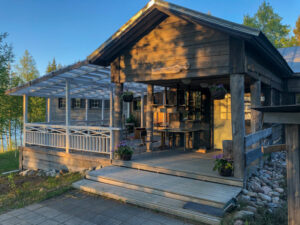
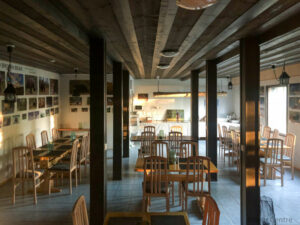
At the restaurant, you can enjoy dinner before heading to the hide, and in the morning after an exciting night, you can join for breakfast. Please let us know in advance if you would like to have a separate dinner or breakfast, so we can prepare the correct amount of food.
The restaurant is open every day from April 1st to September 30th. In February, March, and October, the restaurant is open when service is needed.
Shop
At the Bear Center, you will also find a small shop where you can purchase snacks, drinks, and some small items you may need during your stay.
If you find that you need to buy something, just ask the staff, and we will try to get it for you.
Smoke sauna
At the Bear Center, we have a smoke sauna that can be used. Please note that heating the smoke sauna takes many hours, from 6 to 9 hours.
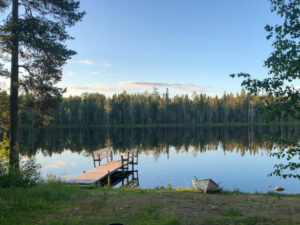
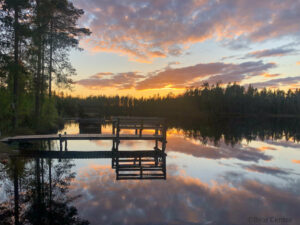
Travel periods
Departures from 01/04/2025 to 31/10/2025Prices
From 515€Ask for a quote
Pricing information
Price per person in Euros
Based 2 persons
OUR RATES INCLUDE :
- 1 night in cabin for 2 people
- The dinner
- The breakfast
- Free use of the photography hides.
- Daytime, different activities at different prices
Good to know
You will like also
Beach stay in Nallikari
Enjoy life by the sea. Welcome to Nallikari! The long sandy beach, the vibrant natural surroundings, and the stunning location ensure that you will create unforgettable seaside memories. With a variety of accommodation ...
the 01/01/2025 and 31/12/2025 From
115€
REGION
Finland
THEME
Apartment, Family, Hotel, Stay, Villa
ACTIVITIES
Canoe, Fatbike, Hiking, Midnight sun, Sauna, Swim, Walking
DURATION
2 nights
DIFFICULTY
Very easyAuthenticity at Hotel & Spa Resort Järvisydän
The experience at Järvisydän is always closely linked to the surrounding nature. The renowned resort offers unique experiences throughout the year on the picturesque Lake Saimaa. Nature is omnipresent, in the infrastructure, ...
the 01/01/2025 and 31/12/2025 From
125€
REGION
Finland
THEME
Charm & Luxury, Cottage, Gastronomy, Hotel, Sustainibility, Villa
ACTIVITIES
Multi-activities
DURATION
1 night
DIFFICULTY
Very easyStay at Radalla Resort
Radalla Resort is surrounded by bare rocks and lush forest on Kiikarmäki hill, along with a coastal pathway along the beautiful Lake Urajärvi. In the mornings, you can enjoy a colorful ...
the 01/01/2025 and 31/12/2025 From
130€
